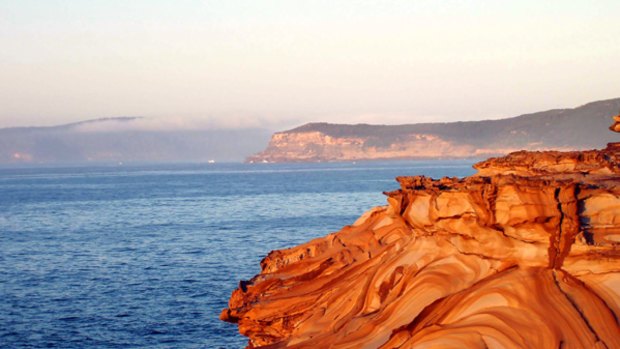
Educational escape ... sandstone swirls in Bouddi National Park.Credit: Jan Forrester
There is nothing like watching a bunch of adults trawling rock pools with the curiosity and unalloyed pleasure of children. We are on Putty Beach in Bouddi National Park on the Central Coast, just south of Gosford. At our backs and further up the rock platform are the sun-fired honey swirls and rust-red striations of weathered sandstone that winds around the coastal cliffs. Directly in front, drifting in and out of a salty mist, is the hammerhead shape of Barrenjoey Headland on Sydney's northern tip. Around the coast to our right is the mouth of the Hawkesbury River.
A group of us are here for the weekend and have pitched our tents at the 18-site camping area. It's early Friday evening and it's rush hour: campers arrive, picnickers unpack and fitness fanatics race along the coastal track to Maitland Bay. Twenty locals are having a candle-lit dinner in the picnic area, while above us, in the Central Coast suburb of Killcare, homes sit on the escarpment like a row of expensive teeth.
At twilight, a group of us take a walk along the sandstone platform at the eastern end of the beach. Even in fading light we are captivated by the textures of sandstone laterite, weathered over millions of years into waves, swirls, blocks and honeycomb-like states - it looks like an oven full of sunken pies or what geologists call a tessellated pavement. The sandstone formations have a gastronomic effect on our group: in the shapes we see, and almost taste, is forbidden, fattening food.
Early next morning, a man stands on the edge of the same sandstone platform gazing south to the fog-filled mouth of the Hawkesbury River, rocking slightly like a wavering statue. Higher on the platform, a woman has found a natural sandstone seat and is meditating.
At low tide, Newcastle ecologist John Simpson leads us across the sand, describing the 35 or so organisms that provide the food maintaining Putty Beach's ecology. He tells us many beaches have lost these multi-level food creators through what he calls "beach grooming" by local councils to get rid of cigarette butts and syringes. Ironically, years ago, Putty Beach lost quite a bit of its facade through sand mining to make lime.
We slide into the knee-deep ends of rock pools, filled as they are with gastropods grazing on algae and predators moving in on the grazers. Who would have believed a quiet rock pool could be such an evolutionary hotbed? Spurred on by this enthusiastic ecologist, we are nursing an elephant slug, one of the many gastropods that live at the base of the marine food chain. It's an oval shell-shaped grazer with soft horns, whose black, gel-like surrounding mantle secretes a new shell.
I discover the rock-hugging limpet is a single-shell mollusc (a gastropod and hermaphrodite to boot) that opens its mouth and collects the nutrients that flood over in every wave. What a life; no wonder it doesn't move outside its square-metre territorial boundary. Nearby is a rock covered in barnacles and a predatory snail, the black-striped mulberry whelk, feasting unobtrusively on top.
Back at camp, we lunch on organisms further up the food chain and then bus to Maitland Bay for some high-tide snorkelling. Rain threatens and the waters are murky. A wobbegong shark is the main attraction - we spot it floating above a large patch of brilliant green sea grasses just off the beach.
Maitland Bay is the centrepiece of the 300-hectare marine extension to Bouddi National Park, one of the first in NSW where all marine life is protected. Although the diehard fishermen we saw on the beach haven't quite accepted this.
Four of us walk back to Putty Beach; two are Aboriginal women who point out the local flowers - native fuschia, flannel flowers and the delicate pink Philotheca salsolifolia. It's an ambling coastal walk through woodland, heath and more sandstone sculpture.
The track includes a boardwalk between Gerrin Point and Putty Beach. The views of Broken Bay are astonishing.
The northern foreshore below us is the graveyard of several ships from the earliest days of the Port Jackson colony.
For this small slice of heaven we can thank Sydney solicitor Marie Byles who, back in the 1920s, saw the natural park values of this place and got the Federation Of Bushwalking Clubs behind her to lobby state authorities for a public recreation area.
That night it's a downpour - a wet end to a great day. Rain doesn't stop the kids in the camping ground entertaining themselves. It's that kind of place - easy to camp, walk, snorkel, swim, surf or just hang about and dream. The marine extension of the park is a special feature of this small gem, a remnant area of the original natural landscape. Long may the gastropods graze.
TRIP NOTES
Bouddi National Park has several camping grounds. It's 95 kilometres north of Sydney via the Pacific Highway and nine kilometres south of Gosford. The Putty Beach camping ground can be reached easily by car from Killcare. The roads are sealed.
Drinking water, flush toilets, cold showers, picnic tables, electric-gas barbecues, rubbish bins.
Phone (02) 4320 4200 (general), (02) 4320 4203 (camping inquiries). Detailed Bouddi National Park information at environment.nsw.gov.au/parks/RegionSydney.htm.
Sign up for the Traveller Deals newsletter
Get exclusive travel deals delivered straight to your inbox. Sign up now.